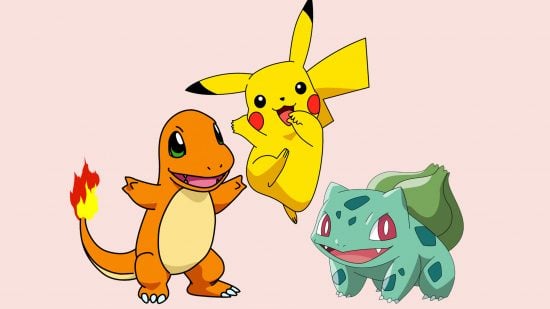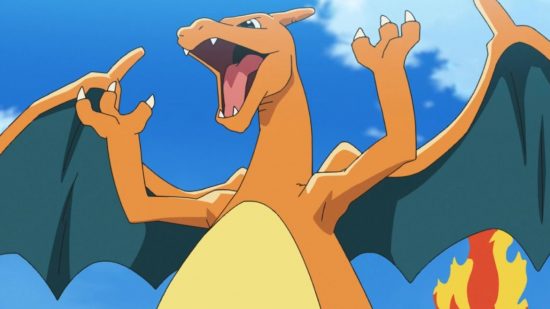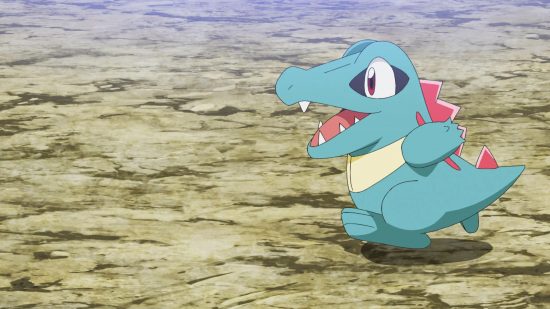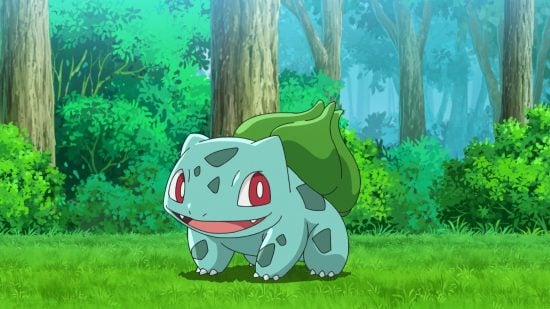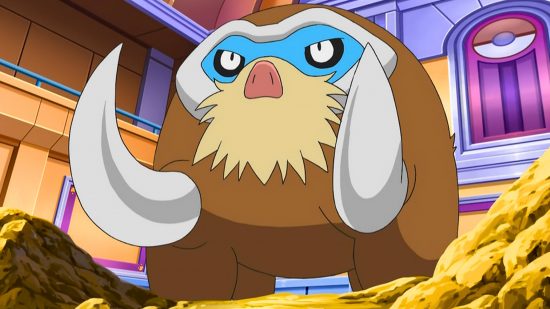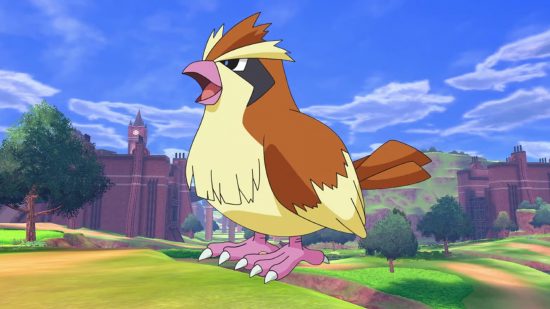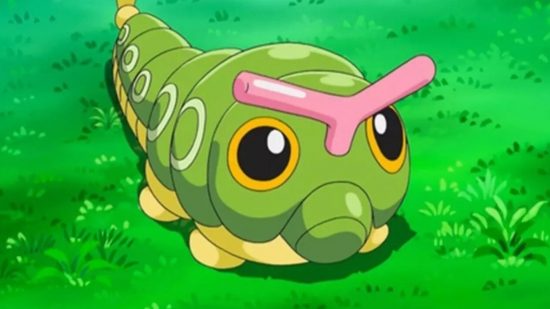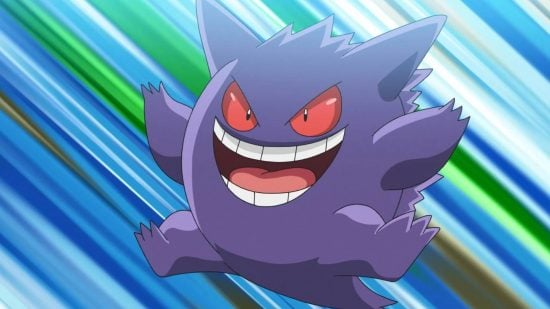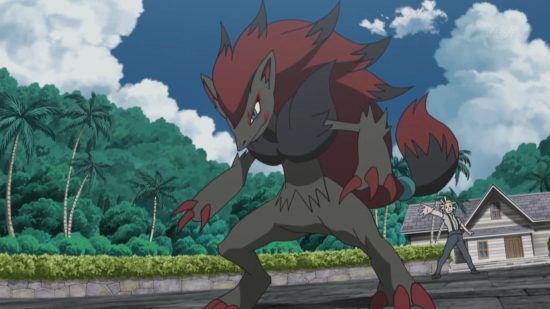In 2023 there are more Pokémon types than ever, with the current number of types standing at 18 since Pokémon X and Y released in 2013. Every Pokémon has a type which determines the moves it has access to, as well as which other types it tends to be stronger and weaker against in battle. This guide lists all Pokémon types, their key strengths and weaknesses, and prominent Pokémon from each type.
Type interactions form the backbone of every Pokémon game, from the original Red and Blue, to Pokémon GO, to the Pokémon TCG. With the answer to the big question ‘how many Pokémon are there?‘ now in quadruple figures, a reliable knowledge of Pokémon types and matchups is vital – especially when crafting the best Pokémon decks.
For the record, in the Pokémon TCG, these 18 types are condensed into a shorter list (only 11 total), with some slightly different names. We recommend you read this guide first to understand the main system, then hop over to our Pokémon card types guide to learn the differences.
If you’re looking to get started in the TCG, check out our guides on how to play Pokémon cards, how to build a Pokémon deck, and our hall of fame for the best Pokémon cards. We’re also tracking the most expensive rare Pokémon cards, if that’s your jam. For now, though, let’s get typing.
Pokémon Type Chart
Before we zoom in on each type and how it works, here’s the full Pokémon type chart, so you can look up the different types and get an idea of how they match up at a glance. You can click on an individual Pokémon Type on the left to find out more.
| Attack | Defence | |||
| Pokémon Type | Super Effective Vs. | Not Very Effective Vs. | Resistant to | Weak to |
| Normal | None | Rock, Steel, Ghost (Immune) | Ghost (Immune) | Fighting |
| Fire | Bug, Steel, Grass, Ice | Rock, Fire, Water, Dragon | Bug, Steel Fire, Grass, Ice | Ground, Rock, Water |
| Water | Ground, Rock, Fire | Water, Grass, Dragon | Steel, Fire, Water, Ice | Grass, Electric |
| Grass | Ground, Rock, Water | Flying, Poison, Bug, Steel, Fire, Grass, Dragon | Ground, Water, Grass, Electric | Flying, Poison, Bug, Fire, Ice |
| Electric | Flying, Water | Grass, Electric, Dragon, Ground (Immune) | Ground, Water, Grass, Electric | Ground |
| Ice | Flying, Ground, Grass, Dragon | Steel, Fire, Water, Ice | Ice | Fighting, Rock, Steel, Fire |
| Fighting | Normal, Rock, Steel, Ice, Dark | Flying, Poison, Bug, Psychic, Fairy, Ghost (Immune) | Rock, Bug, Dark | Flying, Psychic, Fairy |
| Poison | Grass, Fairy | Poison, Ground, Rock, Ghost, Steel (Immune) | Grass, Fighting, Poison, Bug, Fairy | Ground, Psychic |
| Ground | Fire, Electric, Poison, Rock, Steel | Grass, Flying (Immune unless grounded), Bug | Electric (Immune), Poison, Rock | Water, Grass, Ice |
| Flying | Grass, Fighting, Bug | Electric, Rock, Steel | Grass, Fighting, Ground (Immune unless grounded), Bug | Electric, Ice, Rock |
| Psychic | Fighting, Poison | Steel, Psychic, Dark (Immune) | Fighting, Psychic | Bug, Ghost, Dark |
| Bug | Grass, Psychic, Dark | Fire, Fighting, Poison, Flying, Ghost, Steel, Fairy | Grass, Fighting, Ground | Fire, Flying, Rock |
| Rock | Flying, Bug, Fire, Ice | Fighting, Ground, Steel | Normal, Flying, Poison, Fire | Fighting, Ground, Steel, Water, Grass |
| Ghost | Ghost, Psychic | Normal (Immune), Dark | Poison, Bug, Normal (Immune), Fighting (Immune) | Ghost, Dark |
| Dragon | Dragon | Steel, Fairy (Immune) | Fire, Water, Grass, Electric | Ice, Dragon, Fairy |
| Dark | Ghost, Psychic | Fighting, Dark, Fairy | Ghost, Dark Psychic (Immune) | Fighting, Bug, Fairy |
| Steel | Rock, Ice, Fairy | Steel, Fire, Water, Electric | Normal, Flying, Rock, Bug, Steel, Grass, Psychic, Ice, Dragon, Fairy, Poison (Immune) | Fighting, Ground, Fire |
| Fairy | Fighting, Dragon, Dark | Poison, Steel, Fire | Fighting, Bug, Dark, Dragon (Immune) | Poison, Steel |
Normal type Pokémon
Normal type Pokémon tend to be, well, normal. You’ll encounter them as animals, taking on the forms of creatures that are almost real to life. Rattata, Meowth, Tauros, Sentret, Zigzagoon, Miltank, Tedddiursa, and Bidoof are some of the more famous examples of almost-real Pokémon. They can also be more fantastical, such as in the case of Chansey, Castform, Porygon, Ditto, and the legendary Regigigas.
Unlike most other types, normal Pokémon moves are not super effective against any other type. This makes them a baseline for the entire game, and good all-rounders in a pinch.
Normal Pokémon moves are weak vs Rock and Steel types, and Ghost types are immune to them (though they can still be affected if abilities such as Odor Sleuth or Foresight are in play).
In turn, relatively few Pokémon moves are strong against them, with only Fighting type moves being super effective. They’re also immune to Ghost type moves, which can cause stalemates unless you have alternatives.
Fire type Pokémon
Introduced in the first generation of Pokémon games, Fire type Pokémon have access to moves which harness flames that can Burn their foes. Fire types often form one of the three choices players have at the start of a Pokémon game. With Charmander, Cyndaquil, Torchic, Chimchar, Tepig, Fennekin, Litten, Scorbunny, and Fuecoco all being Fire types you can choose from in their relevant games.
The most famous Fire type Pokémon is Ash’s Charizard from the Pokémon anime. Evolved from Charmander through to Charmeleon, this dragon’s wicked temper caused conflict for the pair.
Eventually, Charizard relented when Ash saved its life, bringing the two together for the first time. This lovable dragon’s fame is evident from the lasting desirability and value of >>Charizard Pokémon cards<<.
When engaging in Pokémon battles, Fire types have moves that are strong against Bug, Grass, Ice, and Steel types. They’re also weak against Ground, Rock, and Water moves. In games where the weather plays a part in the action, Fire type moves are strengthened in harsh sunlight and weakened in rain, or if Water Sport is active.
Water type Pokémon
If messing around among the waves is your thing, then welcome to the splishy-splashy world of Water type Pokémon. These soggy creatures tend to be modelled after fish, turtles, crocodiles, and anything that likes to get itself wet.
Along with Fire and Grass Pokémon, Water type Pokémon are often found at the beginning of each game as one of the three choices presented to you. This is how a trainer will first encounter Squirtle, Totodile, Mudkip, Piplup, Oshawatt, Froakie, Popplio, Sobble, and Quaxly.
In addition to these starter Pokémon, some of the more famous Water types include Psyduck, Krabby, Horsea, Staryu, Poliwhirl, Lapras, Wooper, Wailord, and of course everyone’s favourite – Magikarp.
Water moves are super effective against Ground, Fire, and Rock types. When on the defensive, Water types are weak to Electric and Grass type moves. Weather such as rain can boost the power of Water moves, with harsh sunlight depowering them.
One of the key reasons to always make sure you have a Water type Pokémon on hand in the Pokémon videogames is their ability to learn Surf, a Water move that will let you swim across the many bodies of water found in the Pokémon series.
Grass type Pokémon
If you’ve got a green thumb then you’ll love the range of photosynthesis-friendly Grass type Pokémon. Like Fire and Water Pokémon, Grass types are often the third option you can choose at the start of the game. Bulbasaur, Chikorita, Treecko, Turtwig, Snivy, Chespin, Rowlet, Grookey, and Sprigatito are all options for fresh Pokémon trainers in their relevant generations.
Players will also be familiar with some of the more famous Grass type Pokémon, such as Tangela, Seedot, Pansage, Oddish, Hoppip, Exeggcute, Roselia, and of course James’ Victreebel as seen in the Pokémon anime.
Grass types can be tricky to use in battles, as they have five different types they’re weak against. Grass type Pokémon are weak to Bug, Fire, Flying, Ice, and Poison moves, with Grass moves being super effective against Ground, Rock, and Water. Their moves are powered up when the Grassy Terrain move is in effect.
Electric type Pokémon
Pika-pikaaaa!
Alright, now we’ve got that out of our system, Electric type Pokémon are probably the most famous of all Pokémon thanks to one little yellow mouse named Pikachu. The poster-child for the entire series, Pikachu entered our hearts and our homes via the Pokémon anime, where Ash was given the truculent Pikachu at the start of his journey.
Using electricity as their theme, Electric Pokémon come in many forms. From the sheep-like Mareep to the legendary Raikou, metallic Magnemite, and the spherical Voltorb.
When fighting, Electric Pokémon are super effective against Flying and Water type Pokémon, and they are weak to Ground moves. When Electric Terrain is in effect their attacks are boosted, and Electric Pokémon are immune to Paralysis.
Ice type Pokémon
Not all Pokémon types like the heat; some need to keep things chill. Ice type Pokémon have a variety of shapes and sizes that reflect their affinity with the cold. Sometimes this can take on the form of ice cream, as in the case of Vanillite; other times their forms are more natural like the mammoth-esque Mamoswine.
With later games adding more twists to the formula, some familiar, non-icy Pokémon can have Ice type variants, such as the Alolan Sandshrew and Ninetales, the Galarian Mr. Mime, and the Hisuian Avalugg.
With only one resistance when battling, Ice type Pokémon can be tricky to use. They are resistant only to Ice moves, but they also gain immunity to Freezing, Hail, and Sheer Cold. They’re also weak to Fighting, Fire, Rock, and Steel moves. On the offensive, their moves are super effective vs. Dragon, Flying, Grass, and Ground type Pokémon.
Fighting type Pokémon
Forget all those fancy beams and powers, sometimes you just want to see some Pokémon get into a brawl. Fighting type Pokémon fulfil that need, with punchy Pokémon like Mankey, Machop, Hitmonchan, Timburr, Sawk, Clobbopus, and Throh all bringing the action. If kicking is more your thing then don’t worry, Pokémon has your back in the form of Hitmonlee (who has literally never skipped leg day).
Fighting type moves are super effective against Dark, Ice, Rock, Steel, and Normal type Pokémon – that last one being especially key if you’re stuck fighting a particularly tough Miltank that refuses to stop healing. They are weak to Flying, Fairy, and Psychic moves.
Poison type Pokémon
With 86 Poison type Pokémon available to you as of Generation IX, there’s plenty to pick from if you’re looking to choose your poison. The Serpentine Ekans and Arbok are probably the most famous, with Nidoran, Grimer, Koffing, Trubbish, Zubat, Toxicroak all bringing deadly toxins.
As they are the source of poisons, it makes sense that Poison type Pokémon are immune to being poisoned. Their moves are also super effective against Fairy and Grass type Pokémon, while in return they’re weak against Ground and Psychic moves.
Ground type Pokémon
The ground holds many creatures in the world of Pokémon, each using it to empower their moves with dusty, earthy effects. Some of the most notable ‘mons found in the series are Ground type Pokémon, with Sandshrew, Diglett, Cubone, Phanpy, Drilbur, and Trapinch all burrowing up from underneath your feet.
When engaging in battle, Ground type Pokémon tend to be particularly favoured, as their moves are super effective against a whopping five different types. Ground type moves are super effective against Electric, Fire, Poison, Rock, and Steel types. Grass, Ice, and Water type moves are all strong vs. Ground types, so be careful if you’re matching up against Pokémon of those types.
Though Ground type Pokémon can be strong, it’simportant to remember that they have a key weakness – they cannot hit enemies in the air. This means Flying types, unless brought down to the ground, cannot be hit by a Ground type move.
Flying type Pokémon
Unlike most other Pokémon types, there are relatively few pure Flying type Pokémon. Usually they are mixed with a second type, such as Fire, Normal, Bug, or Poison (see below for more details on dual types).
Examples of this are the Normal/Flying Pidgey, the Fire/Flying Charizard, the Bug/Flying Butterfree, or the Poison/Flying Zubat. That said, there are a few pure-Flying type Pokémon out there, such as Rookidee and Corvisquire.
Flying moves are super effective vs. Bug, Fighting, and Grass type Pokémon, but are weak to Electric, Ice, and Rock moves. Flying types are also immune to Ground type attacks, unless they temporarily lose their Flying type due to an effect such as using the Roost move to heal.
Psychic type Pokémon
The power of the mind can be yours with Psychic Pokémon in your team. Their ability to hypnotise or send out barrages of pure psychic power can be incredibly strong in the right hands.
Pokémon such as Drowzee, Abra, Mewtwo, Mew, Espeon, Unown, Munna, Solosis, Gothita, Jynx, and Mr. Mime show off the huge range and variety of Psychic type Pokémon.
Poison and Fighting type Pokémon are weak against Psychic moves, and Psychic type Pokémon are weak against Bug, Dark, and Ghost moves. Dark type Pokémon in particular can be a tricky matchup, as Dark type Pokémon are completely immune to Psychic moves.
Bug type Pokémon
Collecting Bug type Pokémon doesn’t have to mean dealing with creepy-crawlies, though many are creepy and lots do crawl. Some of the most memorable Pokémon designs fall under the Bug type banner, from Caterpie and Wurmple to Pineco, Beedrill, Paras, Ledyba, Scyther, Venonat, and Shelmet. Pokémon anime fans will especially remember Butterfree for a particularly sob-worthy storyline in which Ash has to say goodbye to his flying pal.
Bug Pokémon have always suffered a little when it comes to battle, as a huge amount of other types have resistances to their moves. In terms of strengths, they are super effective against Dark, Grass, and Psychic type Pokémon while they’re weak to Fire, Flying, and Rock moves.
Rock type Pokémon
Tough, durable, and heavy as heck – Rock type Pokémon are the most resilient Pokémon out there. Like all Pokémon they come in many varied shapes and sizes, such as the tree-esque Sudowoodo to the olfactory-enabled Nosepass. Of course, there are plenty of more rock-like Pokémon, like Roggenrola, Rolycoly, Geodude, Onix, Solrock, and Nacli.
Generally most Rock type Pokémon will have high Defense stats, making a mockery of most incoming attacks. This is counterbalanced by them having low Speed and a large amount of move types that they’re weak to. Rock type Pokémon are weak to Fighting, Grass, Ground, Steel, and Water moves. Meanwhile, Rock moves are super effective against Bug, Fire, Flying, and Ice type Pokémon.
Ghost type Pokémon
Ghost type Pokémon are unusual in the Pokémon world, as they’re immune to a couple of types of damage. Also – they’re dead. That fact is obscured by many of them being quite cute, like Shuppet, Duskull, Sinister, Gastly, Haunter, Gengar, Drifloon, Giratina, and Litwich. Ghost Pokémon’s sinister side is very present in some, however, such as Yamask – which carries a mask of its face from when it was alive. Spooky.
When engaging in Pokémon battles, you’ll find that Ghost moves are super effective against Ghost and Psychic type Pokémon, while they’re weak against Dark and Ghost moves. Normal and Fighting moves have no effect on Ghost type Pokémon, unless a special effect is in play like Scrappy, Foresight, or Odor Sleuth.
Dragon type Pokémon
Some Pokémon types need descriptions. Dragon type Pokémon are not one of these, because they’re all, well, dragons. If you imagine a classic DnD Dragon, you’ll be pretty close to the majority of Dragon type Pokémon. Some are cute dragons like Goodra, Dragonite, Altaria, or Tatsugiri. Some are the fiercer kind of dragon, such as Charizard, Garchomp, Regidrago, Haxorus, or Zekrom.
Dragon type Pokémon tend to be strong in battle, often having the highest HP stat out there. This is balanced by Dragon moves only being super effective against Dragon type Pokémon, with Dragon, Fairy, and Ice moves all being strong against them. Most Dragon type Pokémon may be near-legendary, but they’re far from invincible.
Dark type Pokémon
Introduced in the Gold/Silver era of Pokémon games, Dark type Pokémon were added to be a counter to the overwhelming power of Psychic type Pokémon at the time.
Dark type Pokémon, despite the name, aren’t necessarily dark in design. Some, like the Alolan Meowth, Poochyena, or Absol can be outright adorable. That said, Zoroark, Purrlion, Darkrai, Weavile, and Hydreigon all wave the flag for dark designs.
As they were introduced to bring Psychic type Pokémon down a notch you’ll not be surprised to learn that Dark moves are super effective against Psychic and Ghost type Pokémon.
In addition to this, Dark type Pokémon are immune to Psychic moves, making them a tough opponent if your roster is packed with mind-bending powers. In terms of weaknesses, Dark type Pokémon are weak to Bug, Fairy, and Fighting moves.
Steel type Pokémon
Also added in Generation II, Steel type Pokémon are exactly what it says on the tin – they’re made of metal. Some Pokémon in this type focus around mechanisms and technology, like Meltan, Klink, Bronzor, or Magnemite, while others are creatures infused with metal, like Cufant, Steelix, Skarmory, or Aron.
Similar to Rock type Pokémon in terms of their tough, rough-and-ready profile, these Pokémon are hardy and resistant to attacks. Their moves are super effective against Fairy, Ice, and Rock type Pokémon and they’re weak to Fighting, Fire, and Ground moves.
Steel type Pokémon have the most resistances of any Pokémon type out there, with eight resistances as of 2023. So if you’re looking for a Pokémon that’s super tough to K.O., Steel type Pokémon may be a dream come true.
Fairy type Pokémon
Added in Generation VI, the Fairy type Pokémon are the most recent Pokémon type introduced to the games. Many existing Pokémon were given this type as a result, with Pokémon like Clefairy, Snubbull, and Togepi all gaining this type. Generation VI also saw a large amount of new Fairy type Pokémon be added to the games, like Sylveon, Spritzee, Flabébé, Swirlix, Dedenne, Carbink, and more.
Fairy moves are super effective against Dark, Dragon, and Fighting type Pokémon, which makes them a threat against some of the most resistant and strongest Pokémon out there. On the other hand, Fairy type Pokémon are weak to Poison and Steel moves.
Dual type Pokémon
Some Pokémon have one type, giving them access to one set of strengths and weaknesses. Others have two and are known as Dual type Pokémon, giving them extra strengths – but also taking on the weaknesses of their secondary type.
Sometimes this is an incredible benefit, with the combination reducing or eliminating incoming damage while allowing for increased super effective moves. At other times, it can make a Pokémon incredibly vulnerable, with some Dual type Pokémon being hit by super effective moves from nearly everything. This results in some dual types ending up ultra-resilient, and others becoming the ultimate glass cannon.
For example, the Grass/Steel Ferrothorn is immune to Poison, and resistant to Normal, Rock, Steel, Water, Grass, Electric, Psychic, Dragon, and Fairy moves. The only two types it takes extra damage from are Fighting and Fire, eliminating many of the problems trainers encounter when using a Grass type.
Conversely, we have Dual type Pokémon like Paras, who’s immune to nothing and is weak to Flying, Poison, Rock, Bug, Fire, and Ice. Its resistances are Fighting, Ground, Water, Grass, and Electric, so while it can have a place in your team, its compounded weaknesses can make it more liability than benefit in your roster.
If you’ve made it through all 18 Pokémon types (plus dual types) in this mammoth guide, you’ve got the makings of a true Pokémon master. With this level of attention to matchups and strategy, you’d probably make mincemeat of some our other favorite Trading Card Games, too – like Magic: The Gathering or Yugioh cards.
If you’d rather stick with the pocket monsters, though, you can expand your collection with our guide to the best Pokémon booster boxes, or guard against counterfeits using our checklist for identifying fake Pokémon cards.
Source: Wargamer



